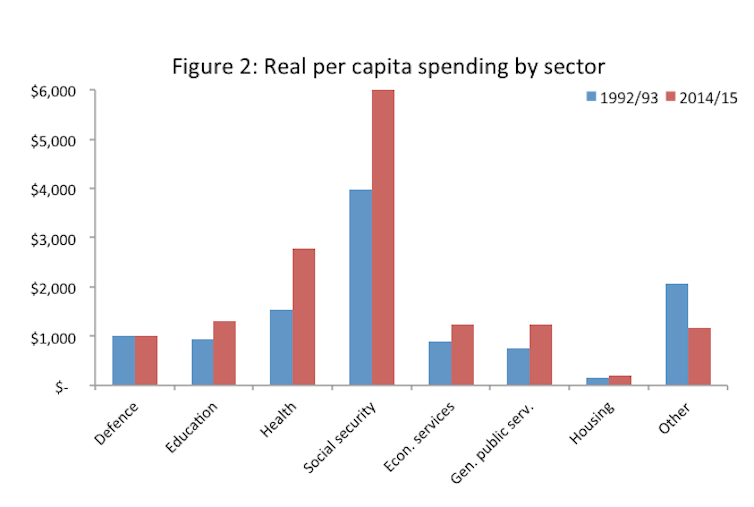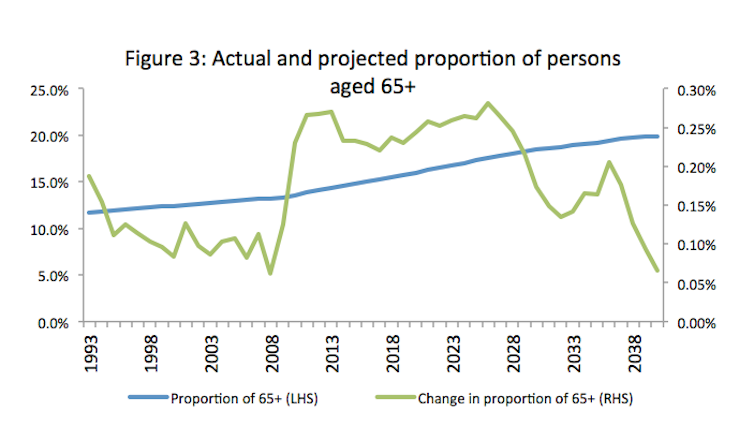Budget explainer: the structural deficit and what it means

Flickr/Jonas Boni, CC BY
Sarantis Tsiaplias, University of Melbourne
In the lead-up to the federal budget there is the inevitable attention given to government spending and debt. But one of the increasingly pressing problems that Australia faces gets a lot less attention than it should. And that is its structural deficit.
To understand this, one must first consider the relationship between revenue and expenditure. Government revenues are largely determined by taxation and are heavily influenced by the ostensibly cyclical waxing and waning of economic conditions, both domestic and overseas.
Expenditure, on the other hand, is a function of underlying economic and demographic conditions and has, in part, counter-cyclical characteristics (with fiscal “stabilisers” such as unemployment benefits rising during an economic downturn). Structural deficits are related to underlying (or longer-term) economic and demographic conditions.
In Australia, the federal government’s expenditure has exceeded revenue in every fiscal year since 2008, and in 21 of the last 35 fiscal years. In recent years the deficit has been particularly large when compared to historical deficits (See Figure 1 below).
Overall, it is reasonable to conclude that the deficit has a significant structural component, and is not simply the product of short term economic woes or fiscal decisions.

Australian government revenues are spent on defence, education, health, social security and welfare, in addition to funding the public sector, distributing revenue to the States and Territories, and paying down debt. In 1993, approximately 2.2% of GDP was spent on defence, 2.1% on education, 3.3% on health and 8.7% on social security and welfare. Today, the spending pie has changed dramatically.
Spending on education and defence has declined, spending on health in the most recent fiscal year increased to 4.1% of GDP and spending on social security and welfare has risen to 9.2% of GDP.
An alternative way to evaluate the changing nature of Commonwealth government spending over the years is to examine spend in per-capita terms. Figure 2 shows per-capita expenditure by area of spend (in real terms) in 1992/93 and in 2014/15. In 1992/93, the Commonwealth spent about $1,500 per person (in today’s dollars) on health expenditure, just under $4000 per person in social security and welfare payments and about $940 on education.
Today, social security and welfare payments are about $6200 per person, health expenditure is over $2700 per person, while education has risen by a significantly smaller amount (to $1300 per person).

Health and social security spending has always been important, and in the last budget spending in these two areas constituted over 50% of the Australian government’s total spend. Real growth in health and social security spending has surpassed 2% per annum over the last 25 or so years, exceeding the annual growth in population which has averaged about 1.4% over this period (and peaked at 2.1% in 2009).
This indicates that the increased expenditure observed in health and social security cannot be explained by inflation or population growth alone.
The crux of the issue seems to lie in the changing demographic of Australia. In the early 90s, about 11% of the population was made up of persons aged 65 or more. Today, this figure exceeds 15%. Put another way, the number of Australians in the 65+ age category has risen by about 2.4% per annum, while the rest of Australia has grown at about half that rate. Indeed, real per-capita health expenditure has been flat over the last 10 years when considering only persons in the 65+ age category.
To place the issue into perspective, Figure 3 shows actual and ABS projections of the number of persons in the 65+ age category over the period 1993 to 2040. Even with a decline in the growth rate of persons belonging to this category, about one in five Australians will be at or above 65 years of age by 2040. In the absence of any change, the budgetary impact of this demographic change will be primarily reflected in health and social security spending.

The obvious question is: how will long-run health and social security requirements be funded? One possibility is to reign in onerous tax concessions. In the post-commodities boom era, however, almost nothing has been done on this front. This includes curtailing costly tax concessions on superannuation (both before and after retirement) and generous concessions on capital gains. Another is a sustained ramping-up of debt levels. The third, of course, is simply a decline in the provision of health and welfare services.
![]() The first option – reviewing tax concessions – seems to be the most sensible in the long run. Indeed, delaying the inevitable simply places the issue in the hands of future taxpayers. To date, however, it is not clear how the major parties on either side of the political spectrum plan to tackle the fiscal issues stemming from Australia’s changing demographic landscape.
The first option – reviewing tax concessions – seems to be the most sensible in the long run. Indeed, delaying the inevitable simply places the issue in the hands of future taxpayers. To date, however, it is not clear how the major parties on either side of the political spectrum plan to tackle the fiscal issues stemming from Australia’s changing demographic landscape.
Sarantis Tsiaplias, Senior Research Fellow, Melbourne Institute of Applied Economic and Social Research, University of Melbourne
This article was originally published on The Conversation. Read the original article.
Allianz Insurance: How to Turn Word Salad into Profit (and Your...
Trump’s Tariff Tantrum—What It Means for Aussie Consumers
The Last American Election?
Pigsfly Newspaper Supporter
Become a Pigsfly Newspaper Supporter
Unlike many online news portals, our website doesn’t hold any annoying advertising, we don’t try and sell you anything nor have we put up a paywall – I want to keep my communiques as open and honest as I can.
Our Pigsfly Newspaper is fiercely independent and they take a fair bit of time, money and hard yakka to produce.
I want to continue delivering Pigsfly Newspaper to you.
But I need your help!
BECOME A SUPPORTER FOR $1 A MONTH
Your support is crucial to maintain the Pigsfly Newspaper
Each year Pigsfly Newspaper cover a range of topics including:
Political nonsense, spin, plain bulls**t, lies and fabrications
Lobbyists
Political donors
Gambling lobbyists and all that entails
Mining and Energy tax avoidance not in the least our continual focus on the ongoing rape of Australia’s precious resources
Tax avoidance and the industry that supports and profits
New twists on business perspectives
Old twists on political party electioneering rorts rip offs and such like
Photography
Music and
Fascinating bits and bobs you would be hard pressed to find elsewhere.
For 2018 several Pigsfly Newspaper Long Reads are planned.
On the drawing board include:
• Politicians and their “Entitlements?”
• The FUA Awards and
much much more
Your support – click below – is greatly appreciated and helps me, continue to help you.
Comments? Write to me through our Contact page
Click the button below to become a Pigsfly Newspaper Supporter for $1 a month






 —
—






